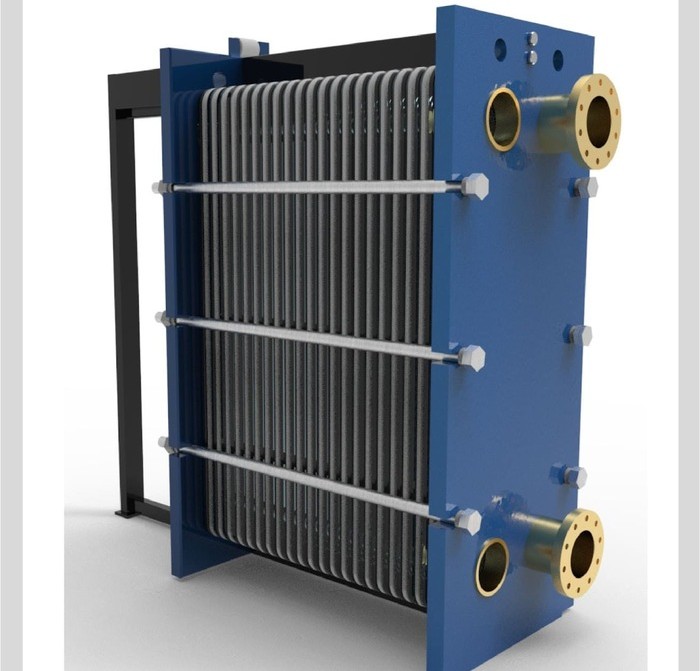Introduction
Plate-and-frame heat exchangers represent a cornerstone in modern thermal transfer technology. Their design, which utilizes multiple thin, flat plates arranged in a frame, allows for an incredibly high heat transfer rate while maintaining a compact size. These exchangers are widely recognized for their versatility and efficiency, making them indispensable across a range of industries including HVAC, food processing, pharmaceuticals, power generation, and renewable energy systems. Their modular design enables easy customization, maintenance, and scalability, adapting effortlessly to various operational demands. In an era where energy efficiency and sustainability are paramount, plate-and-frame heat exchangers excel in reducing energy consumption and optimizing thermal processes. Whether in large-scale industrial applications or smaller, specialized processes, they continue to redefine how industries approach heat management.
Key Applications
- HVAC Systems:
Plate-and-frame exchangers are extensively used in HVAC systems for transferring heat between air and water. They enable efficient heating and cooling in buildings while occupying minimal space. These exchangers ensure consistent indoor temperatures and help in energy-saving by recovering waste heat from air or water streams. - Food and Beverage Industry:
These exchangers are crucial in maintaining hygiene and controlling temperatures during the heating or cooling of perishable liquids like milk, juices, and beer. Their design ensures minimal risk of contamination while offering efficient cleaning and sterilization, which are vital in food safety compliance. - Chemical Processing:
In chemical plants, plate-and-frame exchangers handle corrosive, viscous, or volatile fluids efficiently. Their ability to isolate and manage heat transfer under controlled conditions makes them indispensable for processes like distillation, reaction cooling, and solvent recovery. - Pharmaceutical Industry:
These exchangers are employed in processes such as sterilization, fermentation cooling, and maintaining precise temperatures for drug synthesis. Their easy-to-clean design and ability to prevent cross-contamination are crucial in meeting stringent pharmaceutical standards. - Renewable Energy Systems:
In geothermal and solar heating systems, plate-and-frame exchangers play a pivotal role in transferring heat efficiently from renewable energy sources to usable systems. They enhance the system’s performance while supporting sustainable energy solutions.
Unique Points
- Compact Design:
Plate-and-frame exchangers offer a high heat transfer area within a small footprint. This compactness makes them ideal for applications where space is limited, such as onboard ships or urban installations. - Ease of Maintenance:
The plates in these exchangers are easily removable, allowing quick cleaning and inspection. This minimizes downtime and maintenance costs, especially in industries with continuous operations. - Flexibility:
Modular designs allow the addition or removal of plates to adapt to varying capacity needs. This adaptability ensures long-term usability across changing process requirements. - Energy Efficiency:
These exchangers maximize heat recovery, reducing the need for additional energy inputs. This contributes to lower operational costs and supports sustainability efforts in industries. - Corrosion Resistance:
Built with materials like stainless steel or titanium, plate-and-frame exchangers resist corrosion even when handling aggressive or acidic fluids, enhancing their lifespan. - Multiple Fluids:
They can process different types of fluids simultaneously, making them versatile in handling diverse thermal transfer tasks without compromising efficiency.
Future Trends
- Advanced Materials:
The adoption of new alloys, composites, and coatings enhances durability, thermal efficiency, and resistance to harsh chemicals or extreme temperatures. - Smart Monitoring:
IoT-enabled plate-and-frame exchangers allow real-time tracking of performance metrics, including temperature, pressure, and fluid flow. Predictive maintenance reduces downtime and prevents failures. - Customization:
Industry-specific designs are emerging to cater to niche requirements, such as sterilization in the pharmaceutical industry or compact designs for offshore platforms. - Eco-Friendly Designs:
There’s a growing focus on designs that prioritize energy recovery and reuse, aligning with global sustainability goals. - Miniaturization:
With technological advancements, compact exchangers are being developed for residential use and portable cooling or heating systems.
Innovations
- Graphene-Coated Plates:
Coating plates with graphene improves thermal conductivity while reducing fouling, enhancing overall heat transfer efficiency. - Advanced Gasket Technology:
Innovations in gasket materials improve sealing under extreme conditions, ensuring longevity and reliability. - Hybrid Systems:
Integration of plate-and-frame technology with other heat exchanger types enables optimized performance across applications. - High-Performance Modeling:
Use of artificial intelligence and computational fluid dynamics (CFD) enables precise design and optimization, enhancing performance and efficiency. - Self-Cleaning Features:
Automated cleaning mechanisms reduce manual intervention and ensure consistent performance.
Conclusion
Plate-and-frame heat exchangers have solidified their position as a critical component in the realm of thermal management. Their unmatched combination of compact design, high efficiency, and adaptability ensures they remain relevant in meeting the ever-evolving demands of modern industries. As technology advances, these exchangers are poised to integrate cutting-edge materials, smart monitoring systems, and eco-friendly innovations, pushing their performance to new heights. From reducing operational costs to supporting global sustainability goals, their role extends beyond just heat transfer; they are a symbol of progress and innovation in industrial engineering. Looking ahead, plate-and-frame heat exchangers will continue to play a pivotal role in shaping the future of energy-efficient and sustainable industrial operations.

